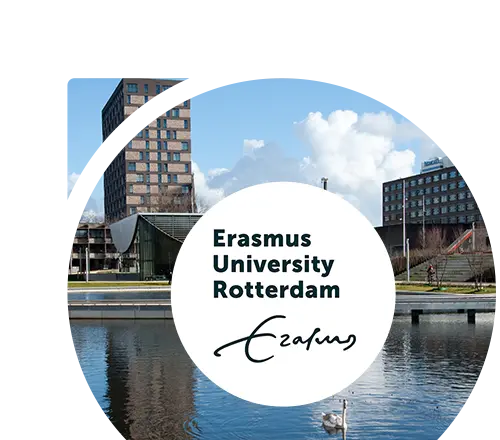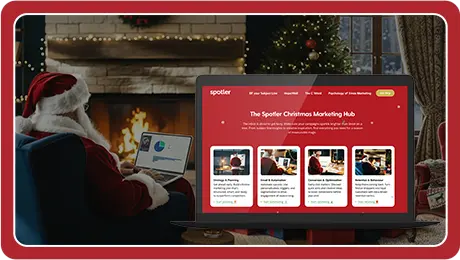Christmas Marketing Hub
From idea to 90% satisfaction: The chatbot success at Erasmus University
Automating answers about tuition fees, delivering 24/7 help, and meeting students where they are with Chatbot Desiderius

The case regarding Erasmus University Rotterdam (EUR) has proven that a chatbot and students go well together. Each year, the university receives numerous questions regarding tuition fees and calls on Spotler Engage for help handling this. Chatbot Desiderius was launched. We spoke to Christa van der Kruk, Marketing & Communication Advisor from the Department of Education & Student Affairs. So, what makes this chatbot such a massive success among students, and what are the benefits of such a chatbot for the university?
A chatbot for even better service to students
Erasmus University has several central departments that students can go to for advice and answers to their questions on various student matters. There is an international office for international students, a language and training centre, student advisors and psychologists, and the Erasmus Student Service Centre, where a team is available daily to help with practical questions. To deal with the increasing number of inquiries regarding tuition fees, Christa decided to look for an automated solution:
“I had heard from the Student Service Center that our employees were frequently being asked questions regarding tuition fees. The chatbot is intended for both prospective and current students. The bot is most relevant for international students, however, because the rules for tuition fees differ for this group. In addition, we wanted to gain some personal experience with using a chatbot, and to test firsthand what we could expect to achieve with automation. ”
Our young target group is “tech-savvy” and can handle new technology well. Students are not afraid to use it either. A student once asked Christa why EUR hasn’t used chatbots yet. “I think that we will all have to deal with Artificial Intelligence sooner or later. I also think that chatbots are a technology that everyone will ultimately use, and they will become the standard”.

90% user-satisfaction
EUR has set a clear objective for implementing the chatbot. Measuring new forms of communication also fits well with Erasmus University Rotterdam’s strategy. A minimum of 60% user satisfaction was set to determine the bot’s success and whether it had served its purpose. Christa says this KPI was more than achieved:
“About 10% of page visitors use the bot and about 80% of everyone who uses the bot also finish the conversation completely. The bot is quite complicated; it contains many questions, and some questions are difficult. No less than 90% of the users are satisfied, which means we are well above our KPI!”
Christa says there’s a marked difference in both the appreciation for and actual use of Desiderius between Dutch and international students. The global target group uses the bot much more and, at the same time, appreciates it more, in both absolute numbers and percentages. This can also be explained by the fact that the rules regarding international students are more complex. It’s made clear by the figures presented by Christa:
“In the 11 weeks after going live, 286 Dutch students made use of the Dutch-language chatbot. The number of international students who used the English-language bot during the same period was 697. That’s almost 2 1/2 times as many. The exact satisfaction percentage, so far, for the Dutch-speaking bot is 85.6%. For the English-speaking bot it’s higher, namely 91.6%.”
Chatbot implementation and PR campaign
Before the bot was launched, a group of EUR employees tested it extensively on content and technology. Once the test period was completed, EUR did a soft launch. Christa: “We didn’t publicise the go-live at all. The bot was live for three weeks before we launched it through a campaign. The funny thing was that people started using the bot right away. I’m pleased we did it that way because things came up that we didn’t see during the test period. For example, the call to action was not clear enough”.
For the PR campaign, the team looked for the best way to reach students. It turned out to be Instagram: “The bot was launched via Instagram through campus bloggers, and we also posted messages on our internal channels that many students read. There was a huge peak in the first two weeks the bot went live. After that, it dropped slightly, and now page visits have stabilised.”
The chatbot had to meet specific requirements at Erasmus University. Several things the team paid attention to and tested during the implementation of the bot:
- Security: The bot can, of course, not be hacked.
- Privacy: How do you handle requesting personal data?
- Accessibility: The EUR website must be accessible to people with disabilities. The chatbot must also meet this requirement by, for example, using speech or being able to select the tab key for the visually impaired.
The future of AI at Erasmus University Rotterdam
The chatbot was launched just a few months ago, but Christa is already considering other possible AI solutions within EUR. In specific areas where a lot of inquiries are made, it seems pretty logical to use bots:
“We’re thinking about how to continue developing this bot. We’re investigating whether we can optimise the chatbot further and perhaps even include more AI. An example would be when users choose buttons and enter text in a text field. Using a bot at the back and front end of the service centre would also make sense. In the back end, for example, by labelling questions, and in the front end, by providing standard answers to simple questions. I can also imagine that we will think further about implementing a choice of study bot.”
Advice for schools or universities considering a chatbot
As advice for other universities or schools, Christa recommends starting with a well-defined topic: “There are so many fun things to think of that you can tackle with a chatbot. But it becomes complicated if you tackle it all immediately and in a big way. Start small and keep things clear and organised. First, gain the necessary experience, then continue developing and expanding from there.”
Christa has experienced firsthand that there is still a lot of confusion among colleagues about what a chatbot can do and that there are some unrealistic internal expectations. “Some people were hesitant when I started working with the chatbot. What does this mean, and what exactly will the bot do? Initially, I still had to do some mission work to make the bot better known and familiar within the university. I did that by talking and explaining a lot and showing examples. Spotler Engage was extremely helpful with this. There were steps that I would have easily skipped, but they were crucial because it’s still a relatively unknown technology.”
Feel inspired by the Erasmus University’s success story?
Discover all Spotler’s chatbots can offer your business and help improve your (customer) service exceed expectations. Sign up for a quick, free demo
Keep expanding your knowledge
Live Chat and WhatsApp: the keys to personal customer contact
Connect with customers via Live Chat and WhatsApp for better customer service. How do you approach this quickly and efficiently?
How Radboud University reaches thousands of national and international students
Radboud University uses WhatsApp and live chat for prospective students with questions. Learn how here.
How to build an omnichannel marketing strategy
In the perfect omnichannel marketing strategy, offline and online marketing channels give the exact same brand experience. Learn how!
Webcare is more than customer service
Are you fully aware of the added value of online customer service for your organisation? In this guide we’re showing you how that works.
WhatsApp-ening in B2B? Turning Chats into Conversions
WhatsApp for B2B? Yes, really! We explain how B2B businesses are using WhatsApp to generate leads, build engagement and support their customers.
WhatsApp Marketing: the Do’s and Don’ts
In this blog we give you useful and practical tips to do your WhatsApp marketing activities in the right way and effectively.
How to build customer loyalty
Of course, customer loyalty leads to repeat purchases, but the goal is bigger: you want them to not only order more often, but also spend more.
Understanding WhatsApp’s new pricing model: the changes from November 2024
Meta has implemented pricing changes at WhatsApp. In this blog, we explain WhatsApp's pricing model and explain the changes.
How Videoland boosted Customer Satisfaction with intelligent chatbots
Spotler’s chatbots helped Videoland increase efficiency by answering common questions instantly, while providing seamless handoffs for more complex issues.
How Zusss increased ROI using dynamic transactional email
See how Zusss turned transactional emails into a powerful marketing tool with Spotler SendPro, offering dynamic content and personalised product recommendations.

